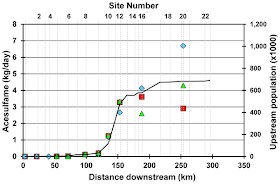From the study published in PLoS One:
Artificial sweeteners have been widely incorporated in human food products for aid in weight loss regimes, dental health protection and dietary control of diabetes. Some of these widely used compounds can pass non-degraded through wastewater treatment systems...The top image shows the sampling sites. The graph below demonstrates that the aquatic concentrations corrrelate with the size of the human population upstream from the sample sites:
In order to determine the riverine concentrations of artificial sweeteners and their usefulness as a tracer of wastewater at the scale of an entire watershed, we analyzed samples from 23 sites along the entire length of the Grand River, a large river in Southern Ontario, Canada, that is impacted by agricultural activities and urban centres. Municipal water from household taps was also sampled from several cities within the Grand River Watershed. Cyclamate, saccharin, sucralose, and acesulfame were found in elevated concentrations despite high rates of biological activity, large daily cycles in dissolved oxygen and shallow river depth. The maximum concentrations that we measured for sucralose (21 µg/L), cyclamate (0.88 µg/L), and saccharin (7.2 µg/L) are the highest reported concentrations of these compounds in surface waters to date anywhere in the world....
The effects of artificial sweeteners on aquatic biota in rivers and in the downstream Great Lakes are largely unknown.
More at the link.


my niece has PKU, and artificial sweeteners are like poison to her. my guess this is just the tip of the iceberg, as far as chemical pollution (Prozac, hormones, anyone?)
ReplyDeleteI am not a doctor, but I don't think this is a serious danger to people with PKU. Therapeutic diets may allow for as little as 300 milligrams of phenylalanine (found in aspertame) for children. Although aspertame wasn't specifically measured in this study if it is similar to the highest of the levels measured ( 21 µg/L for sucralose ) then :
Delete(300 milligrams) / (21 micrograms per liter) = 14,286 liters
or about 3770 gallons of this water would have to be consumed to produce blood levels of phenylalanine above acceptable levels. Of course this is in combination with a diet that contains some phenylalanine so it isn't that simple.
Each gallon of water with a 21 µg/L concentration of phenylalanine adds about 0.08 milligrams toward the (for example) 300 milligram target.
I really do think that modern analytical chemistry is amazing in allowing us to reliably detect microgram per liter concentrations of these compounds.
Example numbers stolen from this example PKU diet for toddlers.
DeleteI don't believe the research was conducted with any intent or hope of finding results indicative of risk to human or biological systems. The take-home message I got from the paper was (as indicated by embeetee below) that measurements of artificial sweeteners may be used as biomarkers to differentiate human waste (vs for example cattle feedlot waste) in riverine systems.
DeleteThat said, it still disturbs me to read about microcontaminations of water by everything from food additives to antibiotics to recreational drugs. I'm saddened by what humans are doing to the world's rivers and oceans.
The conclusion we all leap to is that the paper is indicating a health effect from the presence of artificial sweeteners in the river system, but (a) the paper's purpose and conclusion was solely around the question of whether artificial sweeteners are good tracers of human-derived waste water in a river system; (b) there's no attempt to provide a scale of comparison for the artificial sweetener levels (ie. how do these compare with the levels in foods we consume, or other exposures? the levels are detectable, but do the authors consider them high, and if so against what objective standard?); (c) the fact these are the highest levels reported anywhere in the world is not meaningful without context of whether those levels are a concern *and* the reason these are the highest (ie. is it that few others measure them, or that every country measures them and among the hundreds or thousands of other measures worldwide these are the highest?) *and* how much higher they are than other measurements; (d) throwing in a comment about how "the effects on aquatic biota [note also, no mention of humans] are largely unknown" is worse than unhelpful, as its effect is to cast aspersions without actually attempting to deal with the questions it will undoubtedly raise.
ReplyDeleteAnonymous, no aspartame was found, and while it seems those who suffer the effects of PKU should avoid aspartame I didn't see any mention of other sweeteners; hopefully the sweeteners found are not an issue for your niece even if they are at levels that could be a concern...which these may not be. In the time I spent I couldn't find any studies indicating the levels which those with PKU must avoid.
The old saw that everything is a poison at some level, that dosage is the key, holds here as it does anywhere. If someone told me there was arsenic in my drinking water, it would matter greatly if the concentration was .1mg/L or .0001mg/L
Water pollution *is* a serious problem, including pollution represented by fertilizers, pharmaceuticals, antibiotics from farms/feedlot, and many other chemicals both natural and artificial that we introduce every day into our river systems and lakes. But we need to be careful to look at all the issues, and to insist on clear and rigorous reviews of the risks and impacts.
Drawing any sort of conclusions on health and safety from this paper is unwarranted.